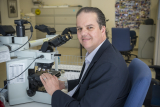Modeling Pediatric Spinal Gliomas Using Murine Spinal Neural Stem Cells

Background
It has been difficult to model pediatric spinal cord gliomas, which include tumors known as ependymoma and astrocytoma, by culturing the cells from patient surgeries in plastic dishes or growing them in mice. This lack of good models has in turn hindered our ability to understand which genetic changes are the key "drivers" of tumor formation and growth and how we might most effectively target these tumors with new therapies.
Project Goal
We plan to overcome this roadblock by using neural "stem cells" derived from the developing mouse spine and grown in culture to generate glioma models by adding the same genetic alterations found in ependymoma and astrocytomas from children. More specifically, we will introduce three distinct sets of tumor-associated genetic changes in order to model pediatric spinal ependymoma, pediatric spinal low grade astrocytoma, and pediatric spinal high grade astrocytoma. This will allow us to better understand which genetic changes in pediatric spinal gliomas are most important for formation and growth of tumors, and how we can treat them more effectively.
Project Update (June 2018)
With the resources provided by ALSF, Drs. Eberhart and Raabe have been able to progress towards the creation of models for three different spinal cord tumors: pediatric spinal ependymoma, pediatric spinal low-grade astrocytoma and pediatric spinal high-grade astrocytoma.
While these three types represent the most common types of spinal cord tumors, samples and genetic models are difficult to obtain: their very location in the spine makes removal difficult without causing significant side effects. To overcome the lack of samples, Drs. Eberhart and Raabe, are using their pathology and oncology backgrounds, combined with existing data about spinal cord tumors and their cells of origin, to generate models in the lab.
The first part of the process—the growing of spinal cord tumor cells—took about one year. The team used murine spinal cells to create and package tumor cells. Part of this process was identifying the culture conditions that would help them to grow most robustly. Then, they added known spinal tumor genetic mutations one by one, watching to identify which seem most critical in tumor growth.
“Compared to adult tumors, there are relatively few mutations in pediatric tumors. We are working to answer the question: ‘what’s the minimum number of mutations you can put into a cell to make it cancer?’” explained Dr. Raabe. “By adding mutations one by one into normal cells, we can figure out how they work together to cause the transformation that leads to cancer growth.”
The team is continuing to watch and evaluate how their models are growing and to identify what mutations and oncogenes could be the key to spinal cord tumor growth. Once identified, the next step will be to test what drugs can be used to suppress those mutations.

